Papers by Pilar Fernandez

Science of The Total Environment, 2021
Bulk atmospheric deposition samples, including wet and dry deposition, were collected during 2004... more Bulk atmospheric deposition samples, including wet and dry deposition, were collected during 2004-2006 in four high mountain European lakes: Skalnate Pleso (Tatra mountains, Slovakia), Gossenköllesee (Alps, Austria), Redon (Pyrenees, Spain), and Lochnagar (Grampian Mountains, Scotland). Samples were analysed for polycyclic aromatic hydrocarbons (PAHs), polychlorobiphenyls (PCBs), hexachlorobenzene (HCB), hexachlorocyclohexanes (HCHs), endosulfans, and polybromodiphenyl ethers (PBDEs). The deposition of PCBs, HCHs, and low brominated BDEs reflected baseline contributions from long range atmospheric transport. This was also the case for PAHs in Redon and Gossenköllesee, endosulfans in Lochnagar and Gossenköllesee and HCB in these three lakes. However, Skalnate received PAHs, endosulfans, and HCB from regional sources as it was the case for endosulfans in Redon. The distinct origin of these pollutants was reflected in the relative composition of some metabolites such as the proportion of endosulfan sulfate vs α- and β-endosulfans or the relative composition of BDE47 and BDE99. Wet deposition was the main process for atmospheric removal of PAHs, HCHs, and HCB. In addition, warm season revolatilization from soils and melting snow with subsequent condensation at low temperature were significant for volatile PAHs, HCB, low chlorinated PCBs, and endosulfans. Reaction with OH radicals was not a significant loss process of HCHs and HCB in remote areas, dominated by wet deposition, whereas PCBs and PAHs were significantly removed by both wet deposition and OH radical oxidation, the latter dominating in the highest altitude sites. Photolysis was the main atmospheric removal process of PBDEs, dominating over atmospheric deposition and OH depletion in all sites.
Journal of Chromatography A, 1994
Significant selectivity differences between semi-polar capillary gas chromatographic columns invo... more Significant selectivity differences between semi-polar capillary gas chromatographic columns involving the elution order of acyclic and polycyclic lipid molecules have been observed. These differences occur despite these columns being reported to be "equivalent" in catalogue specifications. In Part I, the changes in retention indices between columns manufactured by different companies were described. In this paper, it is shown that these variations in selectivity may even be observed among semi-polar columns originating from the same manufacturer.
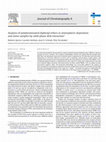
Journal of Chromatography A, 2008
An extraction method for the quantitative analysis of polybrominated diphenyl ethers (PBDEs) in a... more An extraction method for the quantitative analysis of polybrominated diphenyl ethers (PBDEs) in aqueous samples has been evaluated. The analytical methodology includes the sample filtration through glass fiber filter and subsequent extraction of dissolved phase compounds by C18 solid-phase disk extraction. Dependence of extraction efficiency on factors such as pollutant concentrations, sample volume, and stability during storage has been investigated. Mean extraction efficiencies of 97% for total PBDEs (13 trito heptabrominated congeners at spiking levels in the range of 15-90 pg) with a RSD between 9 and 20% were achieved. Higher recoveries were observed for the more volatile PBDEs (112%) in relation to more brominated congeners (88%). The developed methodology was successfully applied to the analysis of these compounds in atmospheric deposition and snow samples from remote sites in Europe with method detection and quantitation limits in the range of 2.1-10 pg L −1 for almost all congeners, which allow the determination of PBDEs in remote areas with levels in the range of low to medium pg L −1 for PBDEs.
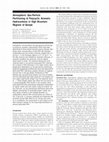
Environmental Science & Technology, 2002
Atmospheric concentrations and gas-particle partitioning of polycyclic aromatic hydrocarbons (PAH... more Atmospheric concentrations and gas-particle partitioning of polycyclic aromatic hydrocarbons (PAH) have been determined at three remote mountain areas in Europe. Gasphase mean concentrations of total PAH (20 individual compounds) were very similar at all sites, ranging from 1.3-2.6 ng m-3 in the Pyrenees (Spain) to 2.7-3.7 ng m-3 in the Alps (Austria) and Caledonian mountains (Norway). A seasonal variability was observed, with the highest levels found in winter. The seasonal differences were reflected better in the particle-associated PAH, showing the increase of PAH emissions in the colder months and a temperature dependence of the gas-particle partitioning. Significant geographical differences were also observed for particulate PAH, indicating a greater influence of regional sources than in the gas phase. Partitioning of PAH between gas and particulate phases was well-correlated with the subcooled liquid vapor pressure in all samples, but with slopes significantly steeper than the expected value of-1. These steeper slopes may reflect the occurrence of a nonexchangeable PAH fraction in the aerosols, likely associated to the soot carbon phase. Comparison of absorption to organic matter and soot carbon using the octanol-air (K oa) and soot-air (K sa) partitioning coefficients shows that, despite uncertainties on estimated organic matter and soot carbon contents in the sampled aerosols, K oa underpredicts aerosol PAH concentrations by a factor of 0.6-2 log units. In contrast, predicted and measured high mountain aerosol PAH differ by 0.2-0.6 log units when K sa is considered. The results point to soot carbon as the main transport medium for the long-range distribution of aerosol-associated PAH.
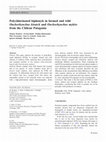
Environmental Science and Pollution Research, 2010
Purpose This paper analyses the presence of polychlorinated biphenyls (PCBs) in escaped: farmed a... more Purpose This paper analyses the presence of polychlorinated biphenyls (PCBs) in escaped: farmed and wild salmons in southern Chile, analysing their concentrations and congener profiles in two species (Oncorhynchus kisutch and Oncorhynchus mykiss). Methods Muscle samples from both farmed and escaped fish of two species, O. mykiss (rainbow trout) and O. kisutch (coho salmon), were analysed for PCBs (42 congeners). To differentiate between the wild salmon and the salmon that have escaped from fish farms, the astaxanthin content in the muscular tissue was analysed with a high-performance liquid chromatography-diode array detector method. PCBs were measured by gas chromatography with an electron capture detector. Results The levels of astaxanthin can be used to differentiate between farmed, escaped and wild-borne salmons with statistically different concentrations. When comparing the total PCB concentrations for both trout and salmon samples, it can be determined that a separate analysis for farmed, escaped and wild-borne fish more accurately describes the real differences in the concentrations; these differences are hidden when separate analyses are not performed. The congener profiles are similar in both trout and coho salmon, where the tri-, tetra-and penta-CB congeners are the most abundant. Conclusion This study is the first report of PCBs in wildborne, farmed and escaped salmons for the Southern Hemisphere, considering that Chile is actually one of the principal world producers of salmon.
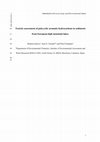
Ecotoxicology and Environmental Safety, 2010
Sediment quality guidelines and toxic equivalent factors have been used for assessment of the tox... more Sediment quality guidelines and toxic equivalent factors have been used for assessment of the toxicity of sedimentary long-range atmospherically transported polycyclic aromatic hydrocarbons (PAHs) to the organisms living in high mountain European lakes. This method has provided indices that are consistent with experimental studies evaluating in situ sedimentary estrogenic activity or physiological response to AhR binding in fish from the same lakes. All examined lakes in north, central, west, northeast and southeast European mountains have shown sedimentary PAH concentrations that are above thresholds of no effect but only those situated in the southeast lakes district exhibited concentrations above the indices of probable effects. These mountains, Tatras, are also those having PAH concentrations of highest activity for AhR binding. Chrysene+triphenylene, dibenz[a]anthracene, benzo[k]fluoranthene and indeno[1,2,3-cd]pyrene are the main compounds responsible for the observed toxic effects.

Chemosphere, 1994
Organic extracts (dichloromethane) isolated from airborne particulate matter, collected in two sa... more Organic extracts (dichloromethane) isolated from airborne particulate matter, collected in two sampling sites located in the Barcelona Cit~, were mutagenic in the Salmonella typhimurium (TA98 +/-$9) bioassay. The highest direct-actiug mutageuicity (69-78 rev m-~) was detected during fall and spring, which corresponds to the highest levels of mutagenic nitroarenes (248 to 350 pg m-3). On the other hand, the highest level of indirect-acting mutagenicity was obtained in summer, paralleling with the highest concentrations of polycyclic aromatic ketones and polycyclic aromatic quinones. Furhermore, the sources of PAil in the urban particulate matter were estimated from the ratio of the less reactive components (i.e. benzoflurantheaes / benzo[e]pyrene, indeno[l,2,3-cd]pyrene / benzo[ghi]perylene, methylphenantherenes I phenanthrene) and reflected a predominance of pyrolytic mobile sources (i.e. vehicular emissions). Nevertheless, a contribution of stationary sources in winter was also apparent. Finally, the seasonal variability of polycyclic aromatic ketones, quinones, aromatic lactones and aldehydes reflected a major contribution of the atmospheric transformation processes from related PAH rather than a direct emission from combustion sources.

Chemosphere, 2010
This paper documents the accumulation and emerging levels of Persistent organic pollutants (POPs)... more This paper documents the accumulation and emerging levels of Persistent organic pollutants (POPs) such as polychlorinated biphenyls (PCBs) and polybrominated diphenyl ethers (PBDEs) found in the tissues of the migrating salmon species Oncorhynchus tshawytscha (Chinook salmon) in the Chilean Patagonia area. Even though salmon are not native to the southern hemisphere, reports indicate that Chinook salmon in the last few years have performed natural free-living style cycling, returning to rivers in the southern Patagonia area. Our study seeks to determine the presence and levels of PCB's and PBDE's in wild Chinook salmon in the northern part of the Chilean Patagonia, analyzing their relation with physiological parameters. Fish were sampled at the end of their entire life cycle when they returned to two principal rivers in the Aysen region in southern Chile. A number of fish (12) were sacrificed in situ and muscle samples were taken for PCBs measurements (sum 44 congeners) by gas chromatography electron capture detector (GC-ECD) and a number of PBDEs congeners, by gas chromatography mass spectrometry with negative chemical ionization detection (GC-MS NCI). Observed levels and patterns were characterized by concentrations of these POPs for PCBs ranging between 78 and 25.5 ng g(-1) wet weight and for PBDEs ranging between 272 and 1046 pg g(-1) wet weight, respectively. These ranges are among same levels reported in this same species in the northern hemisphere.
Analytical Chemistry, 1996
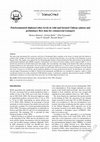
Journal of Environmental Sciences, 2012
This pilot study documented the occurrence and levels of brominated flame retardants in the tissu... more This pilot study documented the occurrence and levels of brominated flame retardants in the tissues of farmed and wild salmon in southern Chile. Samples of Coho salmon and rainbow trout were obtained from fish farms, rivers and lakes in the Patagonia in Aysen Region, Chile. The samples were analyzed by Gas Chromatography Negative Chemical Ionization Mass Spectrometry for the different polybrominated diphenyl ether (PBDE) congeners. Contaminants were observed in all the samples, and the congeners BDE 17, 28, 47 and 66 were observed in all both farmed and wild samples. The concentrations were higher in the farmed Coho salmon, presenting significant differences with wild salmon. The levels reached 182 pg/g wet weight (ww) vs. 120 ww. In the case of the rainbow trout, the concentrations were lower, although the congener profile was quite similar. The levels reached an average of 100 pg/g ww in the farmed fish versus 110 pg/g ww in wild fish, and no significant difference was observed between the species. In both species, the congener with the highest concentration was BDE 47. Based on this information, the BDE flow was estimated for commerce, which is a form of pollutant transport not usually considered in POP pollution studies. A preliminary estimation indicated that the quantity of PBDEs mobilized by commerce was in the order of kg, and in the case of Chile might reach almost 1 kg.
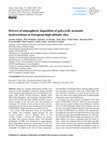
Atmospheric Chemistry and Physics
Polycyclic aromatic hydrocarbons (PAHs) were analysed in bulk atmospheric deposition samples coll... more Polycyclic aromatic hydrocarbons (PAHs) were analysed in bulk atmospheric deposition samples collected at four European high-mountain areas, Gossenköllesee (Tyrolean Alps), Redon (Central Pyrenees), Skalnate Pleso (High Tatra Mountains), and Lochnagar (Grampian Mountains) between 2004 and 2006. Sample collection was performed monthly in the first three sites and biweekly in Lochnagar. The number of sites, period of study and sampling frequency provide the most comprehensive description of PAH fallout in high mountain areas addressed so far. The average PAH deposition fluxes in Gossenköllesee, Redon and Lochnagar ranged between 0.8 and 2.1 µg m −2 month −1 , and in Skalnate Pleso it was 9.7 µg m −2 month −1 , showing the influence of substantial inputs from regional emission sources. The deposited distributions of PAHs were dominated by parent phenanthrene, fluoranthene and pyrene, representing 32 %-60 % of the total. The proportion of phenanthrene, the most abundant compound, was higher at the sites of lower temperature, Gossenköllesee and Skalnate Pleso, showing higher transfer from gas phase to particles of the more volatile PAHs. The sites with lower insolation, e.g. those located at lower altitude, were those with a higher proportion of photooxidable compounds such as benz[a]anthracene. According to the data analysed, precipitation is the main driver of PAH fallout. However, when rain and snow deposition were low, particle settling also constituted an efficient driver for PAH deposition. Redon and Lochnagar were the two sites receiving the highest amounts of rain and snow and the fallout of PAH fluxes was related to this precipitation. No significant association was observed between long-range backward air trajectories and PAH deposition in Lochnagar, but in Redon PAH fallout at higher precipitation was essentially related to air masses originating from the North Atlantic, which were dominant between November and May (cold season). In these cases, particle-normalised PAH fallout was also associated with higher precipitation as these air masses were concurrent with lower temperatures, which en-Published by Copernicus Publications on behalf of the European Geosciences Union.

Ecotoxicology and environmental safety, Jan 26, 2018
The lower course of the Ebro River is polluted with high concentrations of organochlorine compoun... more The lower course of the Ebro River is polluted with high concentrations of organochlorine compounds dumped by a chloro-alkali plant during the last century. A remediation plan, including building of a protective wall, removal and disposal of polluted sediments started in 2012. With the aim of assessing the effects of dredging of contaminated sediments and potential alterations of water quality, areas located upstream (RR) and downstream (BE, A) the chemical plant (FL) were monitored prior (October 2012) and during dredging (June 2013) using roach (Rutilus rutilus) as sentinel organisms. Concentrations of organochlorine compounds (OCs) in fish muscle and biliary levels of polycyclic aromatic hydrocarbons (PAHs), galaxolide (HHCB) and alkyphenols (APEs) were determined together with selected enzymatic activities (7-ethoxyresorufin-O-deethylase (EROD), 7-benzyloxy-4-trifluoromethyl-coumarin O-debenzyloxylase (BFCOD) and UDP-glucuronyltransferase (UGT)) in the liver. The obtained result...

Environmental pollution (Barking, Essex : 1987), Jan 30, 2017
Outdoor ambient air particulate matter and air pollution are related to adverse effects on human ... more Outdoor ambient air particulate matter and air pollution are related to adverse effects on human health. The present study assesses the cytotoxicity and ability to disrupt aromatase activity of organic PM1 extracts from rural and urban areas at equivalent air volumes from 2 to 30 m(3), in human placental JEG-3 cells. Samples were chemically analyzed for particle bounded organic compounds with endocrine disrupting potential, i.e. PAH, O-PAH, phthalate esters, but also for organic molecular tracer compounds for the emission source identification. Rural samples collected in winter were cytotoxic at the highest concentration tested and strongly inhibited aromatase activity in JEG-3 cells. No cytotoxicity was detected in summer samples from the rural site and the urban samples, while aromatase activity was moderately inhibited in these samples. In the urban area, the street site samples, collected close to intensive traffic, showed stronger inhibition of aromatase activity than the sampl...
Atmospheric Chemistry and Physics Discussions, 2015

Environmental science and pollution research international, 2014
The snow capacity for storage of a large number of pollutants such as polybromodiphenyl ethers (P... more The snow capacity for storage of a large number of pollutants such as polybromodiphenyl ethers (PBDE), including BDE-209, polycyclic aromatic hydrocarbons (PAHs), polychlorobiphenyls (PCBs), hexachlorocyclohexanes (HCHs; α- and γ-isomers), endosulfans (α- and β-isomers and the sulphate residue) and hexachlorobenzene (HCB), in a steep altitudinal gradient (1,101-2,500 m above sea level (asl); maximum planar distance 16 km) in a typical European mountain system, the Tyrolean Alps (Austria), was studied here for the first time. Snow samples representing the whole snowpack accumulated at the end of the cold season were collected in all cases. The snow specific surface area (SSA) of these samples, 140-260 cm(2) g(-1), was characteristic of aged snow with low retention capacity. PAHs were the pollutant group in highest concentrations (500-8,400 pg L(-1)). PCBs and PBDEs were found in concentrations of 460-900 and 8.5-290 pg L(-1), respectively. From the fourteen investigated BDE congeners...
Water, Air, & Soil …, 2002
High concentration of Hg, less volatile PCB congeners and p, p'-DDE in Arctic charr from an ... more High concentration of Hg, less volatile PCB congeners and p, p'-DDE in Arctic charr from an arctic lake was mainly causedby biomagnification in the food chain where cannibalism was thedriving force. We suggest that low sediment fluxes of Hg, low net production of methyl ...
Science of the total …, 2004
Polycyclic aromatic hydrocarbons (PAHs) were analysed in liver of fifty-seven individual trout di... more Polycyclic aromatic hydrocarbons (PAHs) were analysed in liver of fifty-seven individual trout distributed among seven high mountain lakes in Europe and one remote lake in Greenland. In all cases, very similar distributions were observed in which phenanthrene largely ...
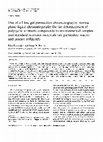
Journal of Chromatography A, 1992
A method involving two levels of fractionation, semi-preparative gel permeation chromatography (G... more A method involving two levels of fractionation, semi-preparative gel permeation chromatography (GPC) and normal-phase liquid chromatography (NP-LC), and capillary gas chromatography with flame ionization and nitrogen-phosphorus detection coupled with mass spectrometry, was developed for the determination of polar substituted aromatic compounds (PACs) in environmental matrices. A GPC clean-up procedure (BioBeads SX-12-dichloromethane) efficiently removed lipidic matter from organic extracts, yielding an enriched PAC fraction. NP-LC (PPorasil) of that fraction provided a selectivity based on chemical classes and moderate to high recoveries for standard PAC. The application of this method to environmental samples and reference materials, air particulate matter (NIST 1649) and marine sediment (HS-4), demonstrated the validity of the procedure for the determination of polycyclic aromatic hydrocarbons (PAHs) from both qualitative and quantitative points of view. Further, a variety of aromatic ketones, quinones and aldehydes (oxy-PAHs) were determined in both matrices.
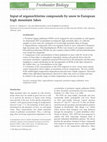
Freshwater Biology, 2009
1. Persistent organic pollutants (POPs) can be trapped by and accumulate in cold regions. To unde... more 1. Persistent organic pollutants (POPs) can be trapped by and accumulate in cold regions. To understand POP accumulation in temperate high mountain lakes, we collected samples of snow from the catchments of several high mountain lakes in Europe. 2. Organochlorine compounds (OCs) are regularly found in snow collected in European high mountain sites. Polychlorobiphenyls (PCBs) were found in all samples examined. Hexachlorocyclohexanes (HCHs) are also common whereas DDTs and hexachlorobenzene were found less frequently. 3. Comparison of the concentrations of these pollutants in snow with OC levels in the waters of these lakes or atmospheric deposition during cold periods shows that the snowpack constitutes a significant seasonal PCB reservoir in all catchments and that snow trapping is a major mechanism for the incorporation of HCHs in the lakes situated in the coldest sites, e.g. Gossenkö llesee in the Alps. 4. Correlation of the concentrations of the PCB congeners in snow versus mean annual winter temperature shows higher accumulation at lower temperatures. The less volatile PCBs exhibit higher temperature dependences than the more volatile congeners. This trend differs from altitudinal dependences observed in other sites such as Canada and may be related to the specific range of winter temperature in each area of study.










Uploads
Papers by Pilar Fernandez